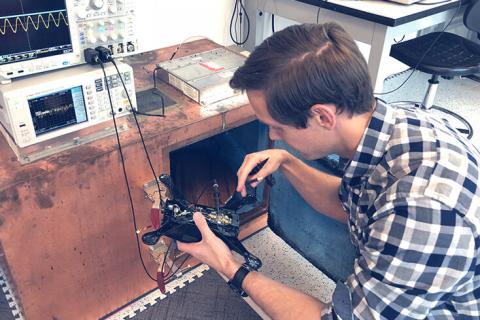At Shield AI, we focus on addressing our customer’s greatest challenges through the application of artificial intelligence to robotics. We make machines that see, understand, and reason about the world so that they can team up to go where other machines, and people, cannot in order to collect and share life-saving information.
Solving problems from a system perspective yields the best solutions. That is our approach to the hard problems we tackle each day at Shield AI. Put a robot in an uncontrolled environment, where it has to contend with thick dust, blinding sunlight, and rain, and it quickly becomes clear that robust autonomy requires performant software and hardware. Throughout the development of Nova, we saw that product performance is best enabled when software innovation is accompanied by hardware innovation.
Enabling autonomous flight in complex, dynamic environments where GPS is unavailable is a formidable software engineering and AI challenge, and this problem is tougher without high- quality hardware that integrates appropriate sensing and computation systems. At Shield AI, we design custom hardware for mission-critical applications while we push the boundaries of the possible. By creating our own hardware, we are able to create a small robot that is hand-launchable, easily packable, and incorporates all the sensors and computing necessary for complete autonomy. The process of creating this quadcopter involved a custom LIDAR, custom computing solutions, custom radios, extensive circuit analysis, modal analysis, thermal analysis, and flow analysis to produce what is arguably the most intelligent autonomous system per unit weight ever created.
This is one example of how high quality hardware can substantially improve system performance. Reliable mapping is necessary for a robot to explore a space logically and without collision. Map accuracy is strongly correlated with the quality of sensor data, and sensor data is degraded by dust, smoke, vibration, sensor aging, moisture, and electrical interference.
By addressing sensor noise through the application of advanced mechanical and electrical engineering techniques, we yielded orders of magnitude higher performance improvement than could be achieved from software- and algorithm-only based approaches.
In this example and a good many others, we benefit from having a team ready to address a problem from hardware, software, and AI approaches. When you can attack a challenge from a series of paths rather than just one, extraordinary performance becomes possible. We believe a holistic approach will be essential to the creation and large scale deployment of intelligent robots which will make a difference for service members, first responders and civilians.
